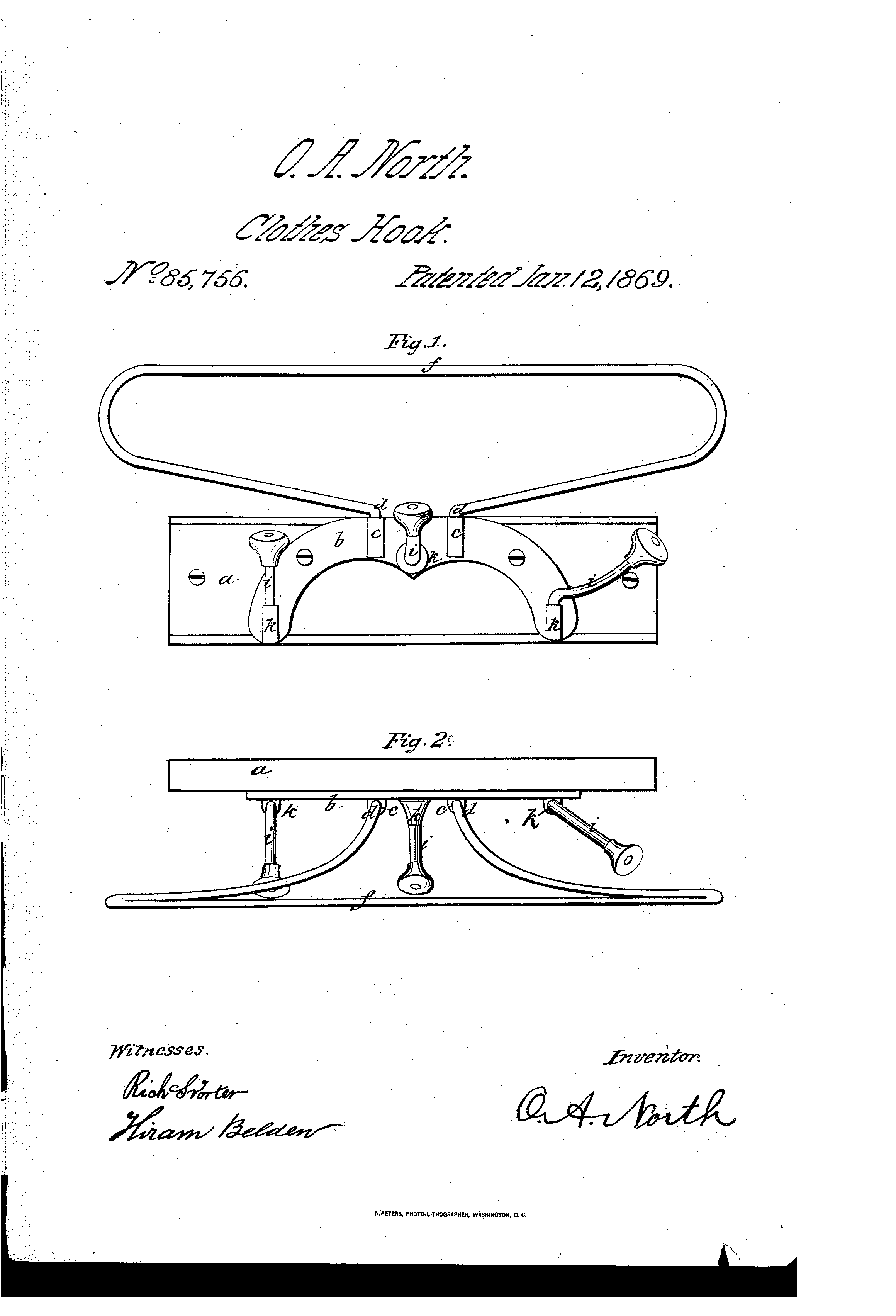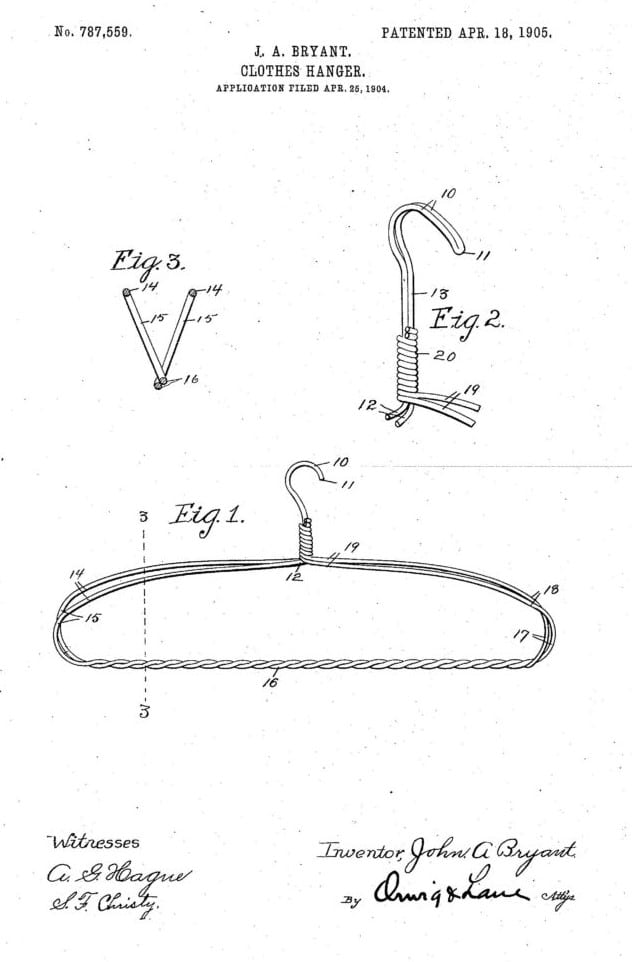Very often, we take for granted many of the everyday objects found around our homes that we nonetheless depend on for our lifestyles.
Let’s take a look at this interesting and little-known History of the Clothes Hanger.
From can openers to remote controls, little inventions make our lives easier. Another of these items is the clothes hanger. Think about it: you probably use multiple clothes hangers every single moment of every single day.
Clothes Hangers preserve and protect some of your most expensive, valuable items. Many of your articles of clothing are always wrinkle-free and ready to wear. What most people don’t realize is that hangers have a fascinating story, beginning with their invention in the 1800s. What is more, they have continued to evolve through the years since they first appeared on the market. Let’s dive into the History of the Clothes Hanger.
Quick Clothes Hanger History Facts
| Who invented the coat hanger? | O. A. North |
| When were hangers invented? | 1869 |
| Where were hangers invented? | New Britain, Connecticut |
| Source: U.S. Patents | |
The Hanger is Born
If you do some digging, you might read that Thomas Jefferson, one of the Founding Fathers of the United States and its third president, invented the clothes hanger. However, this fact is of dubious credibility. While undoubtedly a brilliant and resourceful man who invented a new style of plow, a macaroni machine, and a revolving chair, Jefferson’s version of the hanger bears little resemblance to what we consider a hanger today.
Instead, the first modern hanger was probably invented by a man named O.A. North in 1869. While living in Connecticut, he submitted a patent application for a device featuring a hook on top and what resembled shoulder supports for clothing to the right and left of the hook. Around the same time, others also submitted patents for somewhat similar contraptions.
During the remaining years of the 19th century, more households began to utilize hangers. They became more important with the growth of the middle class and the increasing number of people working as professionals rather than laborers. These people (mostly men) included lawyers, clerks, accountants, and businessmen, and they wore suits to work. They needed to look fresh and well-pressed, but very often did not have the household staff to iron their clothes each day.
For the most part, these early clothes hangers were made of wood.

The Hanger Evolves
Continuing the History of the Clothes Hanger journey, at the very beginning of the 20th century, the hanger evolved to more closely resemble the tool we use today. In Jackson, Mississippi, a man named Albert J. Parkhouse worked at the Timberlake Wire and Novelty Company. While there, he figured out that a piece of sturdy wire could be twisted to form a useful contraption for hanging clothes, especially coats.
His shape featured two ovals on either end, twisted in the center with a hook shape at the top, which was perfect for attaching to a bar, wall hook, or any number of other places.
After Parkhouse’s design caught on, other companies and individuals kept on making improvements to it. In order to make hangers stronger and sturdier, some people began adding wooden reinforcements in the middle especially. Remember that the wire was bendable, and clothing tended to be heavier in the early 20th century than it is today.
The year 1932 was another important evolutionary moment in the History of the Clothes Hanger. A man named Schuyler C. Hulett added inexpensive cardboard to the wire in order to further prevent wrinkling. To this day, many (if not most) dry cleaning companies still use a version of this wire and cardboard design.

The Swinging ’60s
Two important developments in the History of the Clothes Hanger occurred in the 1960s. First, in 1965, Gerhard Wieckmann patented a new hanger design with a wire hook and wooden frame. His innovation prevented wrinkling and solved some other issues with the older design.
The second was in 1967 when J.H. Batts patented an inexpensive molded plastic hanger. While plastics had been invented much earlier, they really took off in the 1960s. This not only made the manufacture of items such as hangers easier, it also made them less expensive to produce and sell. It was around this time that hangers truly became an essential tool in almost every household in America.
As is often the case, a single invention can cause a cascade of other innovations and changes. It was not until after the clothes hanger really caught on that closets became such an important feature in homes, something that we couldn’t dream of not having in houses and apartments today.
The Modern Clothes Hanger
Since the 1960s and the emergence of plastic hangers, we’ve seen more developments, including hangers designed to hold multiple items of clothing, hangers specifically made for particular articles or types of clothing, and more.
There are even luxury and custom-made hangers. Perhaps more importantly, we also have heavy-duty hangers to handle large items. For example, Tough Hook hangers can hold 150 pounds on a single hanger. This innovation is even more impressive when you know about the humble beginnings and slow evolution of the clothes hanger itself.
The Environmental Footprint of Clothes Hangers
The invention of plastic hangers in the 1960s revolutionized the clothing industry, making hangers more affordable and accessible. However, this came at a significant environmental cost.
Plastic hangers, often not recycled, contribute to the growing plastic waste problem. In response, some companies now focus on eco-friendly alternatives, including hangers made from recycled materials or sustainable sources like bamboo. These sustainable hangers serve the same purpose but have a much smaller environmental footprint.
Frequently Asked Questions
Why were clothes hangers invented?
Clothes hangers were invented to preserve and protect garments. They became more prevalent with the growth of the middle class and the increasing number of professionals who needed to keep their suits fresh and well-pressed.
What material were the early clothes hangers made of?
The early clothes hangers were primarily made of wood. It wasn’t until the early 20th century that hangers made of wire started to appear.
Why did clothes hangers start to evolve in the early 20th century?
They evolved to become stronger and sturdier due to the heavier clothing of that era, which the wire hangers at that time struggled to support.
How did the invention of the clothes hanger influence home design?
As hangers became essential, the concept of closets also became a key feature in homes.













